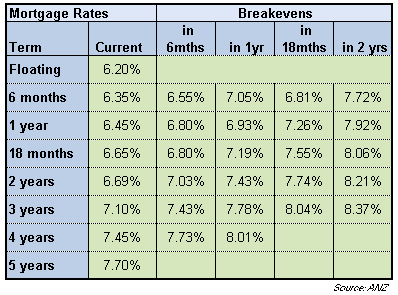Breakeven analysis - how it works
Before jumping into long-term fixed rates, it is useful to undertake a simple break-even analysis to see whether it is worth it according to ANZ.
Thursday, September 23rd 2010, 12:57PM 4 Comments
4 Comments
In its Property Focus ANZ says breakeven analysis is a simple tool to help with decisions such as fix or float, and if I fixed what term should I have?Like most decisions there are no hard and fast rules - a lot depends on your individual circumstances.
But ANZ says it is often staggered by the lack of analysis that goes into the fixing decision.
Break-even analysis is a simple tool to help with that decision.
In the context of mortgage rates, it is the calculation of a set of future mortgage rates that are mathematically implied by the set of current interest rates.
For example, if the one-year interest rate is 5.50% and the two-year rate is 6.25%, we can use this to imply a breakeven one-year rate in one-year's time of 7.00%.
In other words, if we choose to fix for one-year at 5.50%, and in one-year's time we then refix at a rate less than 7.00%, we will have made a better decision than fixing for two-years at 6.25%, and vice versa.
Because of the effect of compounding, it is not equal to exactly 7.00%, but it is very close, and the rough rule of thumb goes like this: two-years at the two-year rate = 2 x 6.25% = 12.5%.
Therefore, if we know two-years will cost 12.50% interest in total, what does that imply for the second year? The answer is: 12.50% in total less the first year at 5.50% = 12.50% - 5.50% = 7.00%.
Of course a lot of people don't view it that way. They make the error in thinking that because the rate you might face in a years time could be above 6.25%, you'll be worse off, when the break-even is in fact 7%.
Given this, consider the current set of fixed mortgage rates as follows:
One thing is immediately obvious with the breakeven levels for the current set of fixed rates six monthly for the next two years - and that is that all breakeven rates are higher than current rates.
This is intuitive, because when long term rates are higher than short term rates, that implies that either the market expects interest rates to rise over time (so they charge more to lend for longer); or they need a premium to lend for longer; or both.
It isn't possible to separate the two, and while there is nothing a borrower can do to avoid the term premium (which is set by the market), it is still useful to know how breakevens compare against your view.
The latest breakeven tableis in Latest Trends and ANZ explains what it means for borrowers.
Before jumping into long-term fixed rates, it is useful to undertake a simple break-even analysis to see whether it is worth it according to ANZ.
Thursday, September 23rd 2010, 12:57PM
In its Property Focus ANZ says breakeven analysis is a simple tool to help with decisions such as fix or float, and if I fixed what term should I have?Like most decisions there are no hard and fast rules - a lot depends on your individual circumstances.
But ANZ says it is often staggered by the lack of analysis that goes into the fixing decision.
Break-even analysis is a simple tool to help with that decision.
In the context of mortgage rates, it is the calculation of a set of future mortgage rates that are mathematically implied by the set of current interest rates.
For example, if the one-year interest rate is 5.50% and the two-year rate is 6.25%, we can use this to imply a breakeven one-year rate in one-year's time of 7.00%.
In other words, if we choose to fix for one-year at 5.50%, and in one-year's time we then refix at a rate less than 7.00%, we will have made a better decision than fixing for two-years at 6.25%, and vice versa.
Because of the effect of compounding, it is not equal to exactly 7.00%, but it is very close, and the rough rule of thumb goes like this: two-years at the two-year rate = 2 x 6.25% = 12.5%.
Therefore, if we know two-years will cost 12.50% interest in total, what does that imply for the second year? The answer is: 12.50% in total less the first year at 5.50% = 12.50% - 5.50% = 7.00%.
Of course a lot of people don't view it that way. They make the error in thinking that because the rate you might face in a years time could be above 6.25%, you'll be worse off, when the break-even is in fact 7%.
Given this, consider the current set of fixed mortgage rates as follows:
One thing is immediately obvious with the breakeven levels for the current set of fixed rates six monthly for the next two years - and that is that all breakeven rates are higher than current rates.
This is intuitive, because when long term rates are higher than short term rates, that implies that either the market expects interest rates to rise over time (so they charge more to lend for longer); or they need a premium to lend for longer; or both.
It isn't possible to separate the two, and while there is nothing a borrower can do to avoid the term premium (which is set by the market), it is still useful to know how breakevens compare against your view.
The latest breakeven tableis in Latest Trends and ANZ explains what it means for borrowers.




Comment